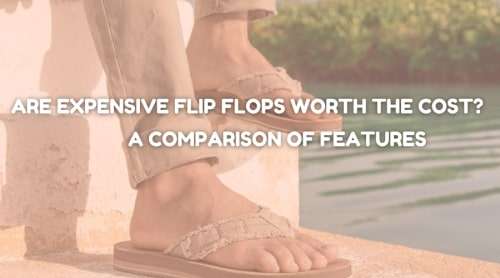-
 sales@fulikaisz.com.cn
sales@fulikaisz.com.cn
-
 13827489472
13827489472
 sales@fulikaisz.com.cn
sales@fulikaisz.com.cn
 13827489472
13827489472

Flip flops are the go-to footwear for summer, beach trips, and casual outings. But when you’re browsing for a new pair and see some with price tags that make your eyes pop, it’s easy to wonder: Are expensive flip-flops worth the cost? After all, how different can a pair of flip-flops really be from the $5 ones you pick up on the way to the pool? Let’s dive into this sole-full debate and compare the features of expensive vs. budget-friendly flip-flops.
Ah, the age-old question: Are you just paying for the logo? While it’s true that some luxury flip-flop brands come with a hefty markup thanks to their name, the difference between those brands and budget options is usually more than skin-deep. Higher-end brands invest in research, innovation, and premium materials that justify their prices.
However, be cautious—some brands may charge more simply for the prestige, so it’s worth doing a little research to ensure that the price tag is backed up by features and not just marketing hype.
At first glance, all flip-flops might seem like rubber and foam, but the reality is far more layered (literally).
Expensive flip-flops often come with higher-quality materials, such as premium rubber, memory foam, or even leather. These fabrics are not only cozy to the touch but also long-lasting. Cheaper flip flops, while practical, are typically built from low-quality rubber or plastic. Ever stepped into a puddle and had your flip-flop turn into a soggy mess? Yep, that’s the risk you take with cheaper materials. Expensive flip flops, on the other hand, are made to withstand the elements and last more than just one season.
If you’ve ever worn flip-flops for a full day, you know that foot fatigue is real. In fact, many podiatrists cringe at the sight of flat, unsupportive flip-flops. Expensive flip flops often include proper arch support, which can save your feet (and back!) a lot of pain.
Brands that specialize in higher-end flip-flops invest in ergonomic designs, cushioning, and footbed technology. You’re not just paying for a name—you’re paying for comfort that can last an entire day. Budget flip flops, by contrast, might be perfectly fine for short walks or lounging, but wear them too long, and you may find yourself hobbling.
It’s a tragic tale: You buy a cute, cheap pair of flip-flops, wear them a few times, and they break mid-step. The dreaded “blowout” (when the strap pulls through the sole) is a common occurrence with budget flip-flops. The lower price might make them an appealing impulse buy, but you may end up purchasing multiple pairs throughout the season.
Expensive flip flops, however, are built with sturdier construction. High-end brands know that their customers expect quality, so they reinforce the areas prone to breaking. When you invest in a pricier pair, you’re often investing in a product that can last several seasons, making it a smarter long-term purchase.
Let’s be real—flip-flops aren’t exactly high fashion. However, more expensive flip flops sometimes prioritize design, with slimmer profiles, better color selections, and materials that do not appear to have been produced in a kindergarten craft class. Some even feature decorations such as beads, metal accents, or patterns, elevating them from casual wear to something you might confidently wear at a summer BBQ.
Cheaper flip flops, while functional, tend to have a “one-size-fits-all” approach to style—basic, bland, and often lacking the design flair that more expensive options offer. If you care about how your footwear complements your outfit, the extra cost might be worth it.
There’s no denying that sustainability is becoming a major selling point for modern consumers, and expensive flip-flops often reflect that. Many higher-end brands are committed to using eco-friendly materials like recycled rubber, cork, or sustainable leather. Some brands even give back to environmental causes, so your purchase contributes to more than just your shoe collection.
On the flip side, cheaper flip flops are often made from plastics and synthetic materials that are less environmentally friendly. They’re usually mass-produced and meant for short-term use, which can add to landfill waste.
When you buy budget flip-flops, you’re saving money upfront, but are you really? If you’re constantly replacing them, that $5 pair quickly adds up over time. Cheap flip-flops can also contribute to foot problems if worn for extended periods. Foot pain, blisters, or discomfort might lead you to invest in insoles, ointments, or worse—a visit to the podiatrist!
On the other hand, expensive flip flops are often designed with long-term comfort and support in mind, which could save you from needing extra medical or footwear accessories down the line.
So, are expensive flip-flops worth the money? In most circumstances, the answer is yes! If you want a pair with better materials, more comfort, and durability, investing in a more expensive alternative may save you money and foot pain in the long term. Sure, you could stick to the budget-friendly route, but just know that you might be replacing them sooner than you think.
Ultimately, it comes down to how often you wear them and what you expect from your fl p-flops. If you’re looking for a quick, casual pair for the beach, go ahead and grab the chap ones. But if you’re planning to wear them daily or need a pair that can go the extra mile, investing in a more expensive pair is probably worth it.